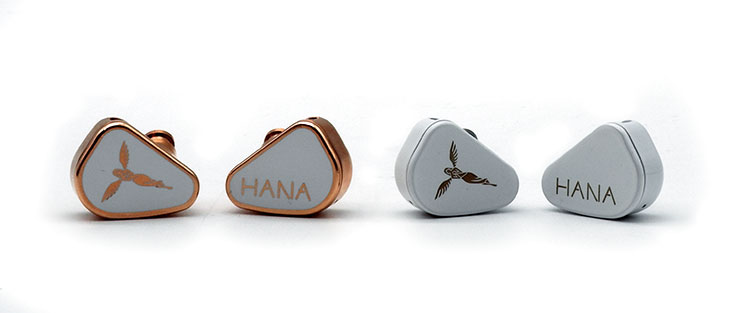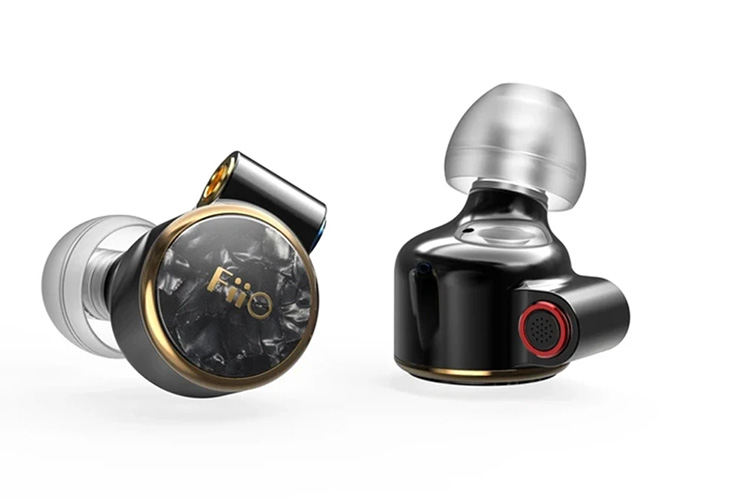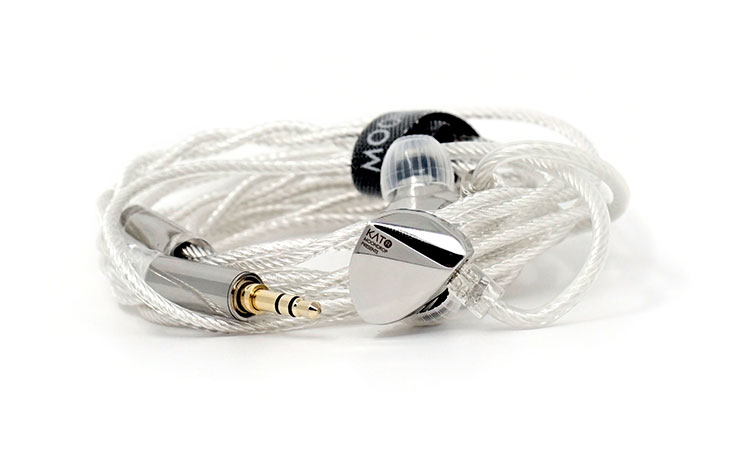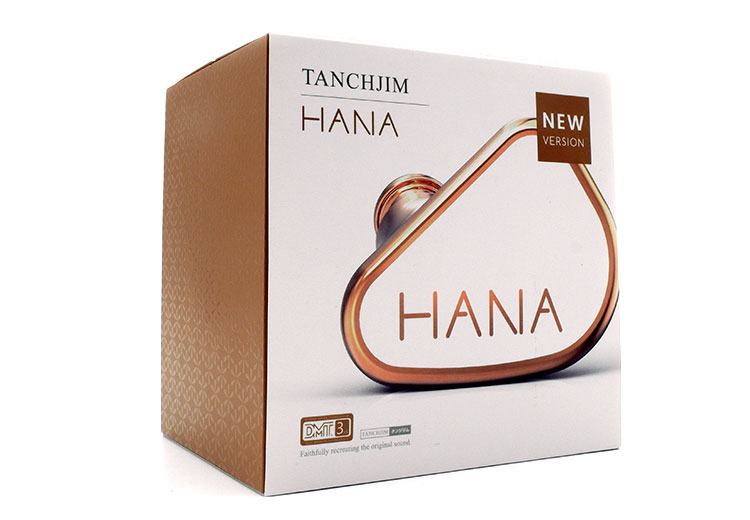Select Comparisons
Tanchjim HANA
$159.99
Technical
With the 2 IEMs being so closely related, it can’t be helped that the technologies inside are very similar. Both IEMs share the same DMT 3rd technology as well as the same Liquid Crystal Polymer diaphragm material.
However, the implementation has changed with the newer version, so the differences are more about the tuning rather than the core technologies that both IEMs share.
Design
At first glance, the 2 IEMS seem like the same IEM but with different colorways. Both IEMs even use the same stainless steel material for the shells making them have approximately the same weight. However, there are 2 significant differences between the 2.
One of my main gripes with the original HANA was that the shells tend to fall off the cable since the 2 pin connection is pretty loose because the pins are shorter than the newer model. Then of course the original HANA uses the porcelain finish throughout the IEM shells, instead of applying some metallic paint.
The rest of the design is pretty much shared between the 2 models, in fact, even the packaging is eerily similar. But I’m actually glad that Tanchjim kept whatever worked well and improved on the little niggles that arose with the original HANA.
Performance
While the visual and technical changes of the IEMs are incremental, the sonic differences between the 2 are more notable. One of the stand out features of the HANA is that they are both extended well into the sub-bass region, ensuring that the sub-bass response is linear particularly for a dynamic driver IEM.
However, with the original HANA, the mid-bass region is more linear, giving it a less pronounced mid-bass response while being more rounded and less textured. This makes drum hits sound more like a solid thump without much texture, particularly when the 2 IEMs are compared side by side.
The original HANA has a more linear midrange response. However, the timbre of both the vocal range and midrange instruments tend to be thinner and less euphonic. This makes vocals less captivating and instruments tend to blend more into the background rather than being put in the spotlight at appropriate times.
When it comes to the treble response, the original HANA has a more pronounced treble region. This gives cymbals and wind instruments more bite while having a more planted treble response. Similarly, the upper treble on the original HANA is also more pronounced, allowing room information to be more apparent.
The soundscape of both IEMs is actually very similar, but the original HANA has a more distinct sense of separation between the images.
Since the images are placed in the same part of the soundscape, the original HANA renders them with a more pronounced outline while the separation may seem more artificially induced comparatively.
Mangird MT4
$199.00
Technical
Instead of using a single dynamic driver, the MT4 has 4 drivers. The first one is a German-made dynamic driver that works as the bass driver. Then midrange is handled by a dual BA driver made by Sonion, and then the treble is produced by a single BA Knowles driver.
Despite the higher driver count, the MT4 ends up being less power-hungry with an impedance of 22Ω, and a sensitivity level of 112dB. This means that the MT4 needed about 10 volume notches lower on the Ibasso DX200 to reach the same volume levels.
Design
While the MT4 is the more expensive IEM, it has a simpler design comparatively. It’s also much lighter since it has translucent plastic shells that are well made, but not as polished as the HANA 2021’s shells. The shells themselves both have a standard-sized nozzle with a lip, so I’m not worried about ear tips getting stuck inside my ears.
Both IEMs use the same 2 pin connection, but the cable on the MT4 is much thicker but seems more like a well-made DIY cable instead of a special cable that’s specifically made for it. However, they are easy to manage both when the IEMs are worn and when they’re in their respective carrying cases, so I don’t have much to complain about.
Overall, the MT4 is the simpler IEM between the 2, but it seems like Mangird allocated most of their resources in the drivers instead of any other external accessories.
Performance
With the higher driver count, the MT4 ends up making details more accessible throughout the frequency spectrum.
Both IEMs are equally well extended, but the bass on the MT4 is more forward while being more controlled, allowing the bass from drum hits to remain tight and textured. However, the MT4 may seem less relaxed comparatively due to its lack of smoothness.
The two IEMs render the vocal presentation with the same amount of texture, but the MT4 doesn’t inject any euphony into the mix. So vocal performances that aren’t particularly captivating won’t be enhanced in any way.
In contrast, midrange instruments such as guitars have a more full-bodied presentation allowing the size of the guitar to be immediately apparent. Pianos also take on that full-bodied tone, while maintaining a semblance of that brighter timbral tilt that makes it sound sweet.
With a BA driver focused on producing treble, the MT4 naturally has a more forward drier treble response. This gives cymbals and wind instruments more energy, making the overall presentation more energetic.
With a more forward midrange, the MT4 also ends up having a more intimate soundstage presentation, making images form closer to my head or even inside my head.
However, both IEMs have a similar ability to place the images both in terms of horizontal directionality and depth, while the MT4 has a more exaggerated outline of the images within the soundstage.
FiiO FD3
$109.99
Technical
What’s similar between the 2 IEMs is that both of them use a single dynamic driver inside stainless steel shells. However, the shells on the FD3 are rounded, instead of the more traditional ear-conforming shape that most other IEMs use.
Also, the FD3 is equipped with a vent at the bottom, making it a semi-open back design instead of a purely closed-back design.
Internally, the FD3 is equipped with a magnetic circuit that is capable of producing up to 1.5 Teslas of magnetic flux density. This makes the magnetic circuit capable of producing more mechanical energy without saturating the magnetic field.
Each voice coil is made with copper-clad aluminum while powering a Diamond-like Carbon dynamic driver making the dynamic driver remain rigid.
While the 2 IEMs employ different technologies internally, the goal of technologies that are employed inside both IEMs is actually quite similar. So I’m guessing that there would be some similarities in the sonic performance?
Design
When looking at the FD3, it has a similarly metallic finish, but this time the FD3 uses a gunmetal finish with celluloid inserts on top that show the FiiO branding. However, the shells on the FD3 are much lighter because they are made of an Aluminum-Magnesium alloy instead of stainless steel.
Also, the shells on the FD3 have a round part, and a stem, which isn’t the most traditional shape for an IEM shell. Furthermore, the FD3 is connected using an MMCX connector instead of a 2-pin connection, which makes it even more secure.
Both IEMs come stock with well-made single-ended cables, but the ones on the FD3 are just braided without an outer PVC sheath. Also, the FD3 cables are even softer making them less microphonic, while being more tangled when I take them out of the carrying case.
Performance
Deploying technologies that have similar goals, I was expecting the 2 IEMs to sound very similar. However, there are notable differences in both the tuning and the technical capabilities of the 2 IEMs.
While both IEMs use a dynamic driver, the one on the FD3 rolls off a bit earlier, losing out a bit more on some sub-bass information.
The FD3 has a more emphasized mid-bass hump while producing a comparatively more loose and less detailed mid-bass presentation. This makes drum hits less rounded while losing out on rendering the size of the drum cavity.
The FD3 editorializes and adds a bit more euphony in the mids making the vocal presentation sweeter. For instruments such as guitars, the FD3 tends to have a more planted fundamental allowing each pluck of the string to be more singular. All this while having about the same amount of detail retrieval.
The treble presentation with the FD3 on the other hand isn’t as forward, meaning it stays safely away from being too bright. Although there is some treble edge, it won’t be as noticeable unless the volume is cranked up. There is also less treble extension making the space between elements within the soundstage less emphasized.
Although the FD3 has a sense of width and layering due to the semi-open back nature of the IEMs, the images formed within the soundstage are less defined. This results in images being placed in the right place while making the delineation between the images a bit more difficult.
Moondrop Kato
$189.99
Technical
Common to both IEMs is that they are both equipped with a single dynamic driver, but this time the Kato’s dynamic driver is 10mm. The implementation of the dynamic driver on the Kato has the objective of achieving a tight, fast, and low distortion performance.
Internally, the Kato is implemented with a DLC(Diamond-Like Carbon) diaphragm to achieve rigidity avoiding any distortions throughout a wide frequency range. The diaphragm is then driven by a Japanese-made Diakoku CCAW coil that’s made with a lighter material to achieve a faster transient response.
According to Moondrop’s marketing material, the Kato is tuned to adhere to Moondop’s VDSF tuning, which is Moondrop’s version of the Harman target response curve.
Design
The most evident similarity between the 2 IEMs is that they both have metal shells that have a high gloss finish. They also both have a similar teardrop shape for their shells, but the one on the Kato has a more defined shape, particularly on the inside part that makes it conform more securely to the ears.
However, the face of the Kato is more of a fingerprint magnet, since the whole shell is made of shiny materials.
Both IEMs also use a 2-pin connection, making their cables interchangeable. However, the cable on the Kato is stiffer, making them more microphonic. However, the Kato’s cable is also more manageable when it’s inside the carrying case since it won’t tangle as much.
With the shallower insertion, the Kato doesn’t offer much isolation, so the 2 IEMs end up being equally comfortable. It’s just that the Kato may be more noticeable for longer listening sessions due to the weight.
Both IEMs isolate from outside noise equally though, which means that they both let some noise in even when music is already playing.
Performance
Comparing the 2 IEMs, the Kato has a brighter tilt comparatively. This is not to be mistaken for the Kato being shrill, instead, the Kato has a milder mid-bass hump making the rest of the frequency spectrum more prominent.
The Kato has a more forward and sharper vocal range, which allows the vocals to come into focus more easily. While the vocal range on the Kato calls more attention to itself, the textures in the vocal range are not as readily available. Interestingly, the breathiness of the vocalist is substantially more prominent on the Kato.
The Kato continues to lend a brighter tilt to the midrange instruments. This gives instruments like guitars and pianos a brighter tilt, making each note more singular while comparatively lacking the fundamentals behind each note.
Aside from being comparatively brighter, the treble range on the Kato also has more bite with each note. Which makes cymbal hits more physical and energetic while having a bit more body behind each cymbal hit.
While both IEMs can accurately place images within the soundstage, the Kato casts a larger soundscape that gives a better sense of the size of the room. The images formed within the soundstage are more vivid and delineated with the Kato, but both IEMs create equally convincing layers within the soundstage.
Our Verdict
When Tanchjim released the original HANA, it’s easy to see that Tacnhcjim took some time in making the HANA look luxurious. This year, they released an update in the HANA 2021, and they have taken the same theme and added an even bolder and more luxurious feel with the addition of even more rose gold accents.
I was initially apprehensive that the HANA 2021 would simply be a visual upgrade. Fortunately, Tanchjim took the original HANA and improved on both the build and sonic capabilities.
I can fully understand why Tanchjim had to release the HANA 2021 so quickly, as it offers a more detailed presentation and an improved tonal balance without losing much in terms of engagement.
Tanchjim HANA 2021 Specifications
- Sensitivity | 110dB
- Color | Rose Gold-White
- Frequency response | 8 – 50kHz
- Impedance I 32Ω
- Total harmonic distortion | < 0.2%
- Diaphragm | secondary polymerization LCP
- Driver | 3rd-Gen DMT Dynamic Driver
- Jack type | 3.5mm gold-plated straight plug
- Cable | 1.2M detachable (0.78 2pin connector)






